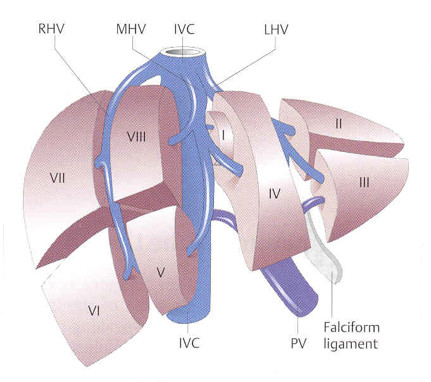Liver Anatomy
The liver is located in the upper right part of the abdomen, just below the diaphragm and weighs about 1.5 kilograms. The liver receives deoxygenated blood rich in nutrients from the intestines through the portal vein (vena portae). Oxygenated blood enters through the hepatic artery (hepatic artery). Once the blood has flowed through the liver, it is returned to the heart through the inferior vena cava (vena cava).
The liver is divided into a left and a right half. This division is made on the basis of the blood vessel supply. For example, the liver can be divided into eight pieces. We call these pieces segments. Figure 1 shows the liver with the segment distribution.

Functions of the liver are
- The liver ensures that sugar is available 24 hours a day, although we eat a limited number of times a day.
- The liver plays an important role in the production and conversion of proteins, vitamins and substances that enable the blood to clot.
- The liver builds, stores and breaks down energy-rich substances.
- The liver is responsible for making all kinds of toxic substances harmless such as medicines and alcohol. One such substance is bilirubin, which is produced by the breakdown of red blood cells. When the liver is not functioning properly, the bilirubin builds up in the skin and mucous membranes. These color yellow, the patient then suffers from jaundice.
- The formation of bile, a liquid that allows the fat-soluble substances to leave the body through the liver and that the fats and fat-soluble vitamins are obtained from food.